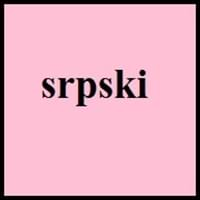Serbian and Luri
Countries
Bosnia and Herzegovina, Kosovo, Serbia, Slovakia
Iran
National Language
Bosnia, Croatia, Montenegro, Serbia
Iran
Second Language
Not spoken in any of the countries
Not Available
Speaking Continents
Europe
Antartica
Minority Language
Croatia, Czech Republic, Hungary, Macedonia, Montenegro, Romania, Slovakia
Not Available
Regulated By
Board for Standardization of the Serbian Language
Not Available
Interesting Facts
- Serbian language was derived from the Old Church Salvic, as the language was commonly spoken by most of Slavic people in the 9th Century.
- Serbian language is based on Stokavian dialect.
Not Available
Similar To
Bosnian and Croatian Languages
Persian
Derived From
Not Available
Not Available
Alphabets in
Serbian-Alphabets.jpg#200
Luri-Alphabets.jpg#200
Scripts
Cyrillic, Latin
Arabic
Writing Direction
Left-To-Right, Horizontal
Left-To-Right, Horizontal, NA
Hello
Здраво (Zdravo)
hello
Thank You
Хвала лепо (Hvala lepo)
Thank you
How Are You?
Како си? (Kako si?)
how are you
Good Night
Лаку ноћ (Laku noć)
Good night
Good Evening
Добро вече (Dobro veče)
Good evening
Good Afternoon
Добар дан (Dobar dan)
Good afternoon
Good Morning
Добро јутро (Dobro jutro)
Good morning
Please
Молим (Molim)
Please
Sorry
Жао ми је (Žao mi je)
sorry
Bye
Довиђења (Doviđenja)
bye
I Love You
Волим те (Volim te)
i love you
Excuse Me
Извините (Izvinite)
excuse me
Dialect 1
Prizren-Timok
Feyli lurish
Where They Speak
Southeastern Serbia
Eastern Iraq, Western Iran
How Many People Speak
Not Available
Dialect 2
Smederevo–Vršac
Bakhtiari
Where They Speak
Serbia
Iran
How Many People Speak
Not Available
Where They Speak
Bulgaria, France, Kosovo, Macedonia, Romania, Serbia
Iran
Speaking Population
Not Available
Second Language Speakers
Not Available
Native Name
српски (srpski) српски језик (srpski jezik)
nanme
Alternative Names
Montenegrin
Lori, Luri, Luristani
French Name
serbe
Not Available
German Name
Serbisch
Not Available
Pronunciation
[sr̩̂pskiː]
[ˈoɽia]
Origin
11th Century
19 BC
Language Family
Indo-European Family
Indo-European Family
Subgroup
Not Available
Indo-Iranian
Branch
Not Available
Indic
Early Forms
No early forms
gd
Standard Forms
Standard Serbian
gd
Signed Forms
Not Available
Indian Signing System
Scope
Individual
Not Available
ISO 639 2/T
srp
Not Available
ISO 639 2/B
srp
Not Available
ISO 639 6
Not Available
Not Available
Language Type
Living
Not Available
Language Linguistic Typology
Subject-Verb-Object
Subject-Object-Verb
Language Morphological Typology
Not Available
Not Available
All Serbian and Luri Dialects
Most languages have dialects where each dialect differ from other dialect with respect to grammar and vocabulary. Here you will get to know all Serbian and Luri dialects. Various dialects of Serbian and Luri language differ in their pronunciations and words. Dialects of Serbian are spoken in different Serbian Speaking Countries whereas Luri Dialects are spoken in different Luri speaking countries. Also the number of people speaking Serbian vs Luri Dialects varies from few thousands to many millions. Some of the Serbian dialects include: Prizren-Timok, Smederevo–Vršac. Luri dialects include: Feyli lurish , Bakhtiari. Also learn about dialects in South American Languages and North American Languages.
Serbian and Luri Speaking population
Serbian and Luri speaking population is one of the factors based on which Serbian and Luri languages can be compared. The total count of Serbian and Luri Speaking population in percentage is also given. The percentage of people speaking Serbian language is Not Available whereas the percentage of people speaking Luri language is 0.00 %. When we compare the speaking population of any two languages we get to know which of two languages is more popular. Find more details about how many people speak Serbian and Luri on Serbian vs Luri where you will get native speakers, speaking population in percentage and native names.
Serbian and Luri Language Codes
Serbian and Luri language codes are used in those applications where using language names are tedious. Serbian and Luri Language Codes include all the international language codes, glottocodes and linguasphere.





